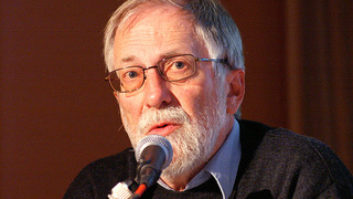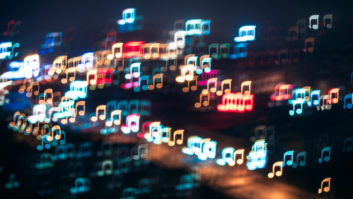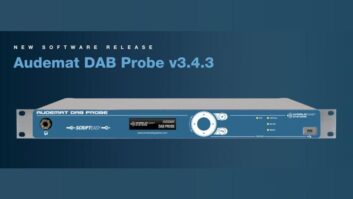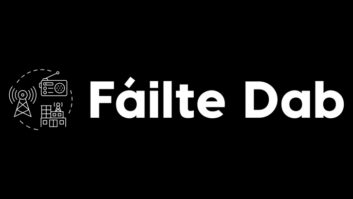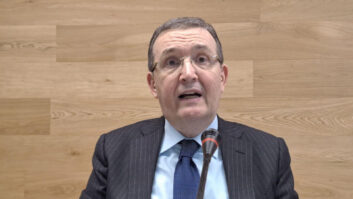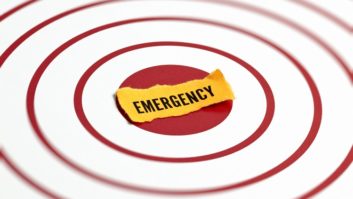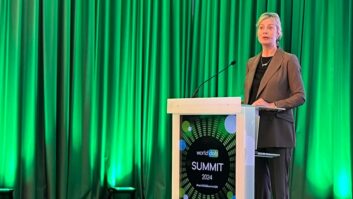The annual WorldDAB General Assembly took place in cyberspace in November. Approximately 300 people joined to hear 35 speakers describe the state of DAB+ digital audio broadcasting around the planet.
Videos of the sessions are available on the WorldDAB YouTube Channel. A sampling:
Gaining ground
In an opening address titled “Strong Progress in Troubled Times,” WorldDAB President Patrick Hannon said 2020 was a good year for DAB+.
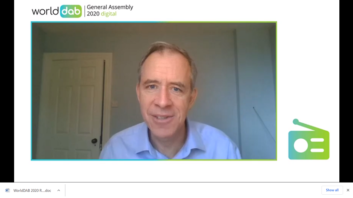
In the UK, DAB listening has overtaken FM for the first time; almost 60% of all listening is digital and 70% of that listening is done using DAB/DAB+ receivers. This trend has prompted the British government to launch a review to help assess consumer habits and support radio in the wider audio market.
In Germany, he said, a second national DAB+ multiplex, launched recently, reaches 83% of the country’s population. In the Czech Republic, existing DAB+ signals now reach 95% of all potential listeners, and Czech Radio revealed plans to start switching off analog services in 2021.
France will launch national DAB+ services in 2021, while Switzerland has confirmed its plans to start switching off analog broadcasts in 2022. In Italy, DAB+ consumer sales almost tripled in the first half of 2020, helped by a regulation requiring all receivers sold from January onwards to include digital capabilities.
Hannon said significant developments were occurring in other parts of Europe, Asia-Pacific, the Middle East and parts of Africa.
Tunisia and Algeria recently launched DAB+ services. A draft regulation for the licensing of digital radio is expected to be published in South Africa by March 2021.
Automotive progress
DAB’s progress in penetrating automobiles was the subject of several sessions. To date, the technology has been successful in staking out space in European automotive dashboards. For instance, in “Norway, Switzerland, the UK and Italy … over 90% of new cars all have digital radios as standard,” said Hannon.
The implementation of the European Union’s European Electronics Communications Code in December, enforced by national laws in EU member countries, will improve matters further. All new car radios sold in the EU will be required to receive DAB+, whether an EU member country has digital radio terrestrial services on air or not.
“COVID-related delays are possible,” Hannon observed, “but critically there’s no major issue … By the end of 2021, the vast majority of new cars in Europe will have DAB+ as standard.”
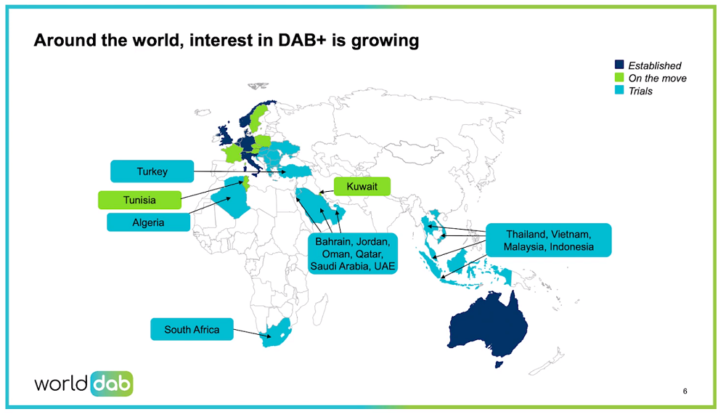
Radio’s place in the car and the competition for in-car listenership were tackled by Roger Lanctot, director of Automotive Connected Mobility with Strategy Analytics.
He said connectivity is the way of the future for automotive infotainment.
“In 2020, for the first time, more than half of all (new) cars will come in with built-in modems,” he said. This is enabling all kinds of in-car listening options including streaming media and hybrid radio, in which a receiver tunes to terrestrial broadcast but switches to the streamed version when the car is out of range.
Now being offered by Audi, with other automakers and equipment manufacturers looking to follow suit, in-car hybrid radio also allows users to search online for their favorite artists/songs and find them on terrestrial radio.
“The key that’s enabling this is the backend metadata infrastructure that’s being provided by multiple suppliers,” said Lanctot. “It’s stitching together that metadata from digital radio that makes radio searchable.”
Looking ahead, Lanctot sees great advertising revenue potential in harvesting in-car listener data. “Companies like Drive Time Metrics are working with automakers to help them understand how to gain insights into the listening behavior of customers in their cars,” he told attendees. “This is a very powerful value preposition that can potentially transform the broadcast industry if we can get at these insights.”
In another session, Guru Nagarajan, lead automotive manager for Google’s Android Automotive, spoke with Xperi SVP of Broadcast Radio Joe D’Angelo about some of the challenges Google is facing in developing the company’s Android Automotive operating system.
“We are learning,” Nagarajan told attendees. “We’ve had 200 automotive OS platform releases now behind us … With every release, we continue to innovate on the platform, expand the interfaces (and) make it more modular.”
According to Nagarajan, radio still accounts for the majority of in-car listening in all circumstances, and will remain important.
“Whether it be a network-constrained scenario in a connected car or (where) you have full connectivity, radio’s continuing to play a key role, and the data is reflecting that,” he said.
Visual experience
But to retain its share of in-car listening via modern infotainment systems, radio broadcasting may need to move beyond audio.
“We all know that radio needs to be a really rich visual experience in cars of the future with bigger dashboard screens,” said Laurence Harrison, chair of the WorldDAB Automotive Working Group. “Metadata is the thing that’s going to power that. Metadata is the visual and textual information about your station that brings your bands alive.”
It is up to broadcasters to provision this metadata to car dashboards. This is why WorldDAB has launched a campaign to encourage broadcasters to provide richer visual and textual data to in-car displays, to attract/retain drivers and passengers as they tune across DAB+ stations.
In doing so, radio can compete against streaming services and music apps that already use striking in-car visuals to lure listeners to their services. This will particularly matter when self-driving cars take over and drivers will be able to enjoy content on large in-car displays rather than watch the road.
Also discussed during WorldDAB’s automotive sessions were “service following” strategies, as listeners move between FM and DAB+ to stay tuned to their preferred radio programs; a RadioDNS open source project that allows broadcasters to track and measure in-car listening across different platforms; and “quickfire” topics in which WorldDAB’s Rosie Smith asked experts for predictions on the future of audio in the car. All can be accessed through the WorldDAB YouTube Channel.
Boosting receiver sales
In a session about “Marketing DAB+” creative ways to build listenership and receiver sales were profiled.
In Germany, DAB+ radio manufacturer TechniSat teamed with Digitalradio Büro Deutschland to sponsor a “Design Your Own Radio” contest. People who logged in at meinradio.dabplus.de/ could use free online graphic tools to customize the case of a TechniSat DAB+ receiver. The best design was adopted for a limited edition radio, with the winner receiving one of these radios.
To maximize DAB+ marketing success in general, “collaboration is key,” said Jacqueline Bierhorst, chair of the WorldDAB Marketing Group.
Bierhorst said promotions by European public and private broadcasters are vital to DAB+’s success in the region. As an example she cited the Netherlands’ recent DAB+ video campaign, which was joined by more than 60 DAB+ channels, with “the most famous deejays and presenters embodying the switch from FM to DAB+” in their TV commercials. Since this campaign launched, DAB+ listening in Holland has gone up 27 percent.
In terms of actual radios sold, DAB+ sales are holding steady across 12 European countries, with 3.78 million DAB+ receivers sold annually in 2019 and 2020.
“Portable radios make up the lion’s share of sales,” said Max Templeman, insight director for consumer electronics with research organization GFK. Portables accounted for about half of all DAB+ radio sales during these two years, with the rest coming from sales of car radios, clock radios, tuners and radio boomboxes; among others.
COVID-19 had an impact on DAB+ radio sales. Thanks to the lockdowns across Europe, online sales’ share of total consumer purchases went from 26% in January 2020 to 60.9% in April 2020. As outlined by Hannon at the start of the General Assembly, ensuring all receivers are equipped with DAB+ as standard is a priority.
